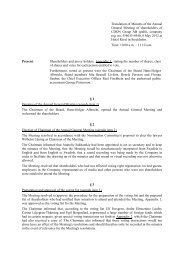Annual Report 2010 - CDON Group
Annual Report 2010 - CDON Group
Annual Report 2010 - CDON Group
Create successful ePaper yourself
Turn your PDF publications into a flip-book with our unique Google optimized e-Paper software.
<strong>CDON</strong> <strong>Group</strong> AB<br />
<strong>Annual</strong> Årsredovisning report <strong>2010</strong> <strong>2010</strong><br />
<strong>Group</strong> contributions that are the equivalent of a dividend are recognised as a dividend. This means that the <strong>Group</strong> contributions<br />
received and their tax effects are recognised in the income statement. <strong>Group</strong> contributions provided and their current tax effects<br />
are recognised directly against retained profits.<br />
<strong>Group</strong> contributions that are the equivalent of shareholder contributions are recognised by the recipient directly against retained<br />
profits with consideration given to the current tax effect. The issuer reports <strong>Group</strong> contributions and their current tax effects as an<br />
investment in participations in subsidiaries, unless impairment is needed.<br />
Note 3 Estimates and assessments<br />
Preparation of the financial statements using IFRS requires that the Board and company management make assessments, estimates,<br />
and assumptions that affect application of the accounting policies and the recognised amounts of assets, liabilities, income, and<br />
expenses. These estimates and assumptions are based on historic experience and several other factors that are judged to be<br />
reasonable taking current conditions into consideration. Resulting estimates and assumptions are used to determine the estimated<br />
value of assets and liabilities that are not otherwise clear from other sources. The actual outcome may differ from these estimates<br />
and assessments.<br />
The estimates and assumptions are reviewed regularly. Changes to estimates are recognised in the period when the change is made<br />
– if the change only affected that period. If the change affects current and future periods, it is recognised in the period when the<br />
change is made and in future periods. The development, selection of, and disclosures regarding the <strong>Group</strong>’s significant accounting<br />
policies and estimates, and the application of these policies and estimates, are reviewed by the <strong>CDON</strong> <strong>Group</strong>’s Audit Committee.<br />
Key sources of uncertainties in estimates<br />
Note 9 contains information about the assumptions and risk factors regarding impairment testing of goodwill and other intangible<br />
assets with indefinite useful lives. Note 17 includes a description of provisions made.<br />
Goodwill and other intangible non-current assets<br />
Goodwill and other intangible assets with indefinite useful lives are tested annually for impairment or when evidence demonstrates<br />
a need for impairment. The impairment test requires that management determines the fair value of cash-generating units on the<br />
basis of projected cash flows and internal business plans and forecasts. For additional information, see Note 9 Intangible assets.<br />
Obsolescence assessment of inventories<br />
Inventories are reviewed monthly to determine possible impairment. An impairment loss is reported in cost of goods sold at the<br />
amount which, after careful evaluation, the inventory is considered obsolete. If true obsolescence differs from estimates or if<br />
management makes future adjustments to the assumptions, changes in valuation can affect the period’s earnings and financial<br />
position.<br />
Provisions and contingent liabilities<br />
Liabilities are recognised when there is a present obligation as a result of a past event, when it is probable that an outflow of<br />
economic benefits will occur and a reliable assessment of the amount can be made. In these cases, a calculation of the provision is<br />
made and recognised in the statement of financial position. A contingent liability is recognised in the notes when a possible<br />
obligation is incurred, but whose existence can only be confirmed by one or more uncertain future events beyond the <strong>Group</strong>’s<br />
63




